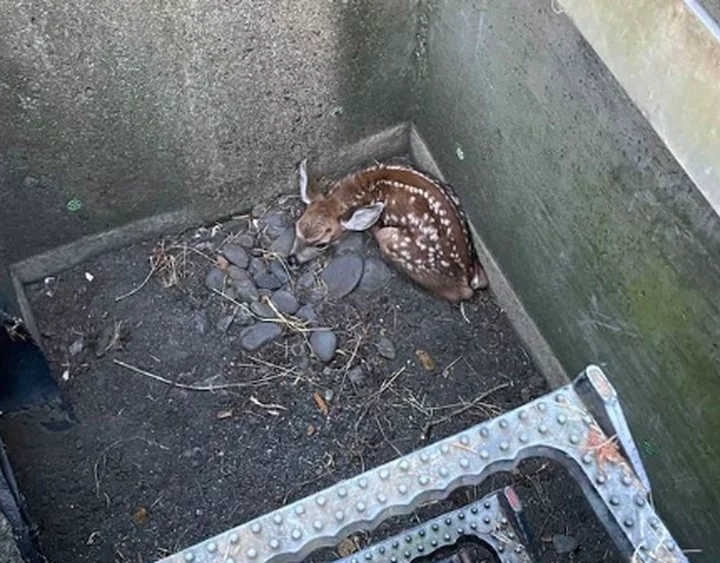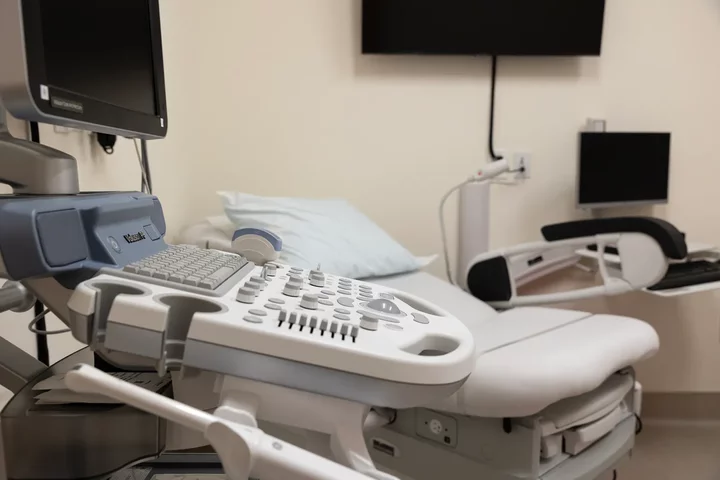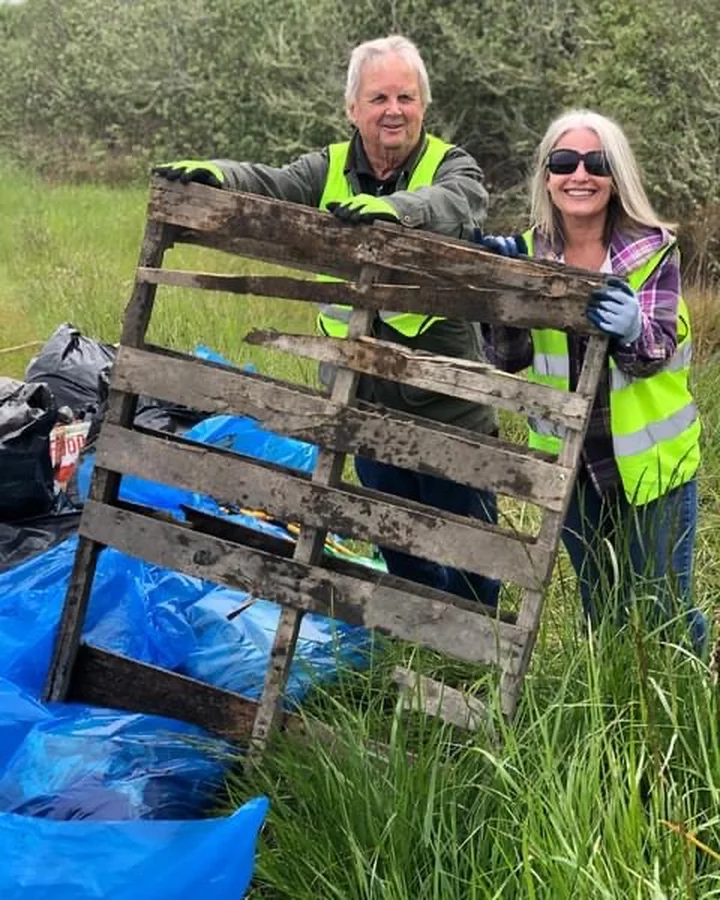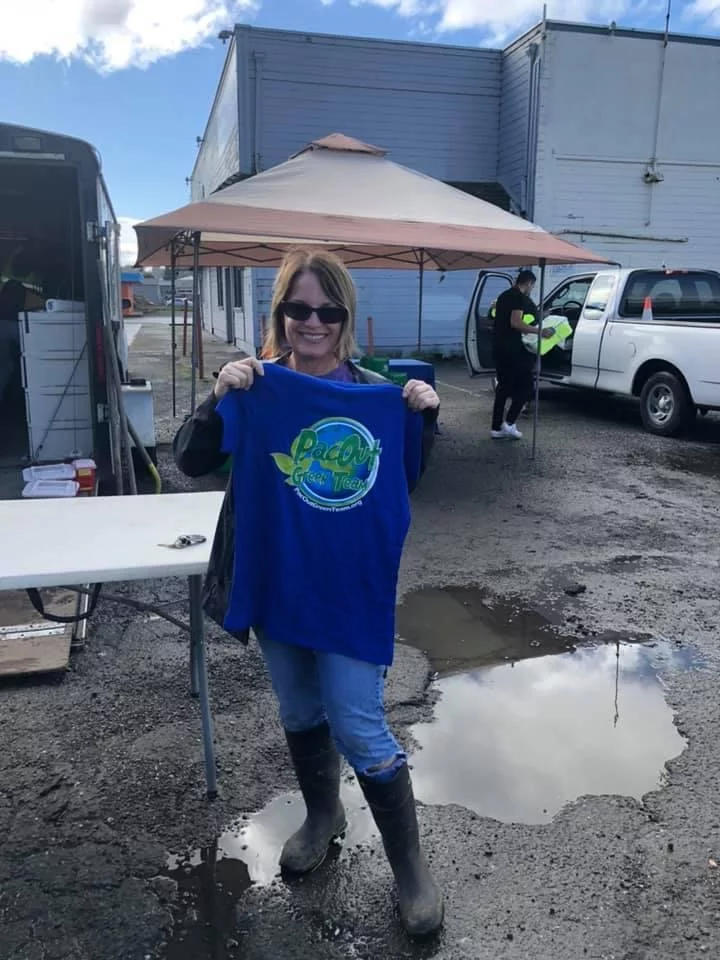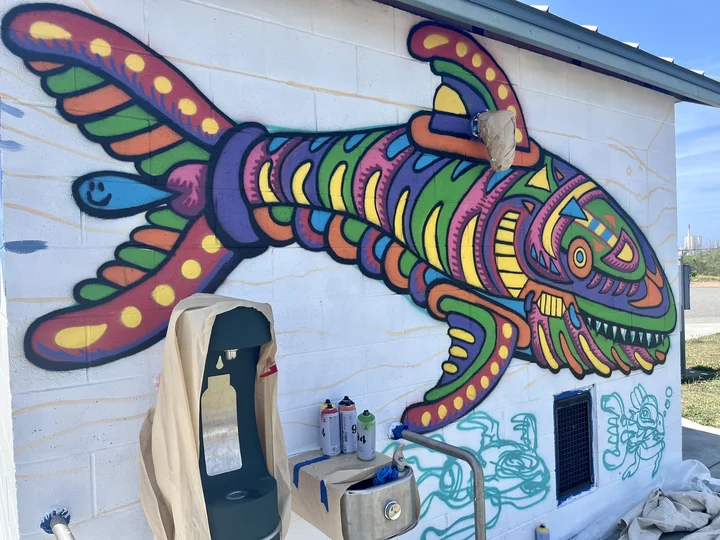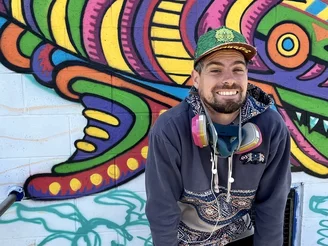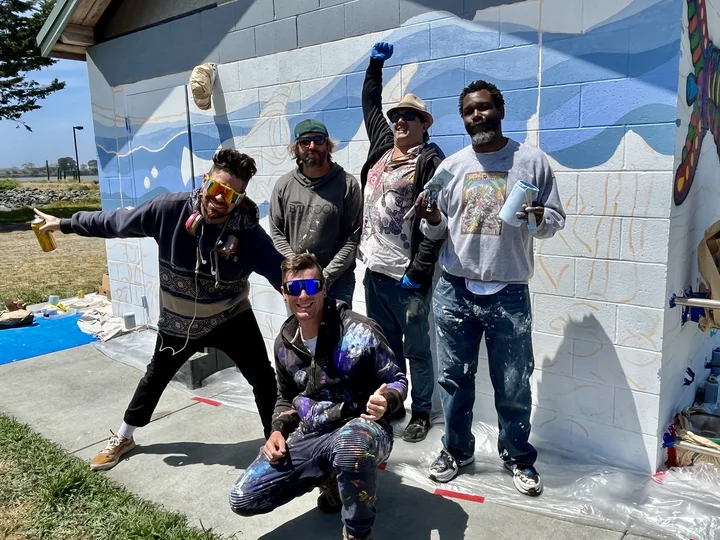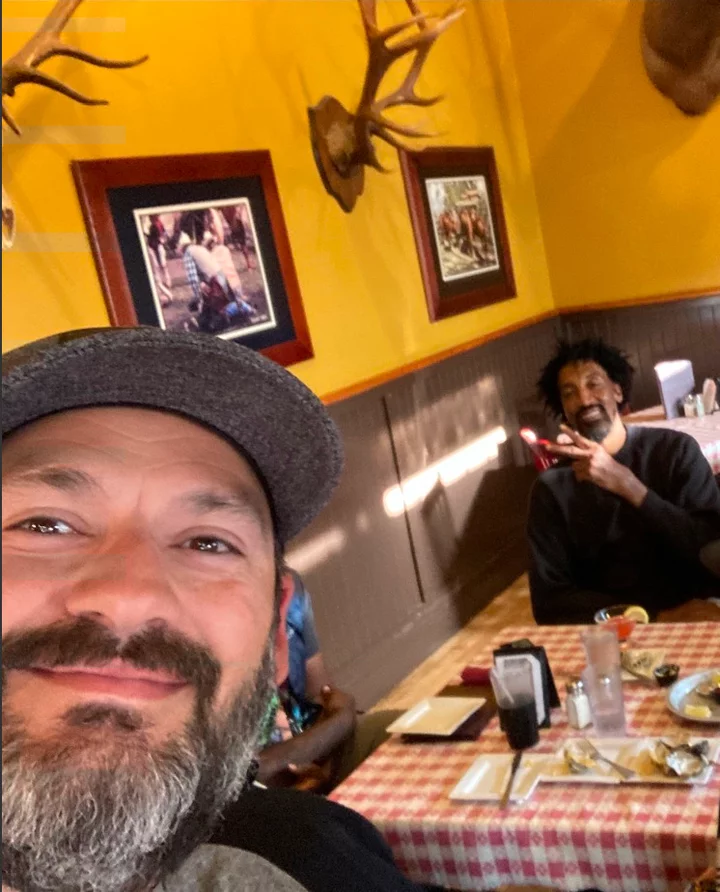Drugs, Illegal Guns and Stolen Vehicles Found in Eureka and Arcata After Weeks-Long Investigation Into Wanted Felon, Drug Task Force Says
LoCO Staff / Friday, June 16, 2023 @ 12:34 p.m. / Crime
Photos: HCDTF.
Press release from the Humboldt County Drug Task Force:
On June 15, 2023, Humboldt County Drug Task Force Agents and HCSO Deputies served a multi-location search warrant at the residences of Cody Ryan Wuillmier (age 31) located in 300 block of Garden Lane in Arcata and the 600 block of Highland Avenue in Eureka. After a multi-week investigation and several neighborhood complaints, the HCDTF believed Wuillmier was in possession of large quantities of narcotics and was in possession of several firearms. Wuillmier is a convicted felon, and he had multiple felony warrants out for his arrest.
Upon arrival at the residence on Garden Lane, Agents and Deputies searched the area. No subjects were located on scene. During a search of the property, Agents and Deputies located two stolen vehicles and a large amount of drug paraphernalia.
After the scene was processed on Garden Lane, HCDTF Agents responded to the 600 block of Highland Avenue in Eureka. While enroute to Highland Avenue, Agents received a tip that Wuillmier was currently staying at a residence in the 3000 block of Central Ave. in McKinleyville. HCDTF Agents responded to the area to surveil the residence.
Once in the area, Agents observed three male occupants in a truck leave the suspected residence and travel southbound on Central Avenue. Agents followed the vehicle into the city of Eureka where it stopped at a business in the 1400 block of 5th Street. Once the vehicle was stopped, Officers with the Eureka Police Department contacted the subjects inside the vehicle.
Wuillmier was located in the back seat of the vehicle. Wuillmier originally provided a false name to the Officers but was positively identified by a photograph and the Officers’ previous contacts with Wuillmier. Wuillmier was removed from that back seat and taken into custody without incident.
Sergeant Nantz with the Eureka Police Department and his K9 partner Bohdie conducted an “open-air sniff” around the outside of the vehicle. K9 Bohdie alerted near the rear passenger side of the vehicle, indicating firearms and/or narcotics may be inside. EPD Officers searched the back seat of the vehicle where Wuillmier was sitting and located a loaded .45 caliber revolver and approximately one ounce of methamphetamine.
Once Wuillmier was in custody, HCDTF Agents authored a search warrant for the residence in the 3000 block of Central Avenue in McKinleyville. HCDTF Agents and HCSO Deputies responded to the residence and served the search warrant. During a search of the residence Agents located a loaded, non-serialized, AR-15, that was equipped with a loaded high-capacity magazine.
Wuillmier was transported to the Humboldt County Correctional Facility where he was booked for the following charges:
11370.1(A) - Possession of a controlled substance while armed with a loaded firearm
29800(a)(1) PC - Felon in possession of a firearm
30605(a) PC - Possession of an assault weapon
25850(A) PC - Unlawful possession of firearm on person/vehicle
25400(A)(1) PC - Unlawful possession of concealed handgun on person/vehicle
12022.1(b) PC - Use of a firearm during the commission of a felony
4573.6 PC - Possession of narcotics in jail
30600(A) PC - Manufacturing an assault weapon
11377(A) HS - Possession of a controlled substance
Warrant Arrest - Multiple Felony Warrants
Anyone with information related to this investigation or other narcotics related crimes are encouraged to call the Humboldt County Drug Task Force at 707-267-9976.
BOOKED
Yesterday: 4 felonies, 12 misdemeanors, 0 infractions
JUDGED
Humboldt County Superior Court Calendar: Friday, Oct. 10
CHP REPORTS
Us101 S / Miranda Ofr (HM office): Trfc Collision-No Inj
Sr3 / Clinic (RD office): Trfc Collision-1141 Enrt
ELSEWHERE
RHBB: Burn Permit Suspension to Be Lifted Monday in Humboldt, Del Norte, Shasta, and Trinity Counties
RHBB: Ukiah Continues Annexation Talks with Local Groups
Governor’s Office: Governor Newsom statement on the passing of Diane Keaton
Governor’s Office: Governor Newsom issues legislative update 10.11.25
Oh Deer! Arcata Fire Rescues Baby Fawn From Storm Drain in McKinleyville Thursday Night
Stephanie McGeary / Friday, June 16, 2023 @ 11:16 a.m. / Animals , Feel Good , News
The poor, frightened cutie trapped at the bottom of a storm drain Thursday night | Image from Arcata Firefighter’s Instagram
###
There’s an old, cliché idea that firefighters spend most of their time rescuing cats from trees. And though that may not be true, they do occasionally get the opportunity to rescue a cute animal. Thursday night Captain Tony Freeman of the Arcata Fire District rescued an adorable baby fawn that was trapped in a storm drain in McKinleyville.
The rescue occurred at about 8:30 p.m. on Thursday on Blackbird Ave., after some bystanders who were on a walk called to say that they heard distressed animal cries and discovered the fawn at the bottom of a storm drain. In a phone interview Friday morning, Freeman told the Outpost that he tried to call Animal Control, but the department didn’t have anyone on shift that late in the day. So, Freeman, along with other responders from AFD and the Humboldt County Sheriff’s Office, took the call. AFD posted the event on its Instagram:
Freeman himself made the rescue, climbing down into the storm drain and picking up the tired and frightened animal, using gloves to be sure not to transfer his human scent. Freeman said that one of the people who made the call also assisted with the rescue by providing a fishing net to cover the drainpipe opening at the bottom of the storm drain, so that the fawn would not try to run into the opening and become further trapped.
Luckily, the little fawn was very docile and allowed Freeman to pick it up with no issues. After rescuing the fawn, Freeman placed it into the nearby wooded area and it scampered away. The animal did not appear to have any injuries, Freeman said.
As for how the fawn got into the storm drain, Freeman is not entirely sure. But he guesses that the fawn was crossing the street with its mother and slipped into the opening at the curb as it was crossing the storm grate. Freeman’s hope is that the mother was still nearby and that it will hear the fawn’s cries and the two will soon be reunited.
Freeman wanted to thank the other responders as well as the community members who called in the incident and assisted with the rescue, and encouraged the rest of the community to report incidents like this.
“We don’t get animal calls too often,” Freeman said. “As soon as this happened, I knew it would make the news. Everyone loves an animal rescue.”
Why ‘Crisis Pregnancy Centers’ Will Be California’s Next Abortion Battleground
Kristen Hwang / Friday, June 16, 2023 @ 7:42 a.m. / Sacramento
An examination room at the Alternatives Pregnancy Center in Sacramento on June 1, 2023. Photo by Miguel Gutierrez Jr., CalMatters
In California, less than two-thirds of counties have an abortion clinic. But nearly 80% have at least one “crisis pregnancy center,” according to a database compiled by CalMatters.
Abortion rights advocates and lawmakers have long accused these centers — also known as anti-abortion centers — of coercing vulnerable people into remaining pregnant by misleading them about abortion procedures and contraceptive methods. In rural areas with acute primary care shortages, “crisis pregnancy centers” outnumber abortion clinics 11 to 2, a CalMatters analysis shows.
While center supporters vehemently deny the accusations about misleading pregnant people, they’ve become the next battleground for California lawmakers bent on protecting abortion rights and offering services for people who live in states where abortion is banned.
“They’re the next way in which the anti-abortion movement will try to stop people from getting access to abortion here,” said Assemblymember Rebecca Bauer-Kahan, a Democrat from San Ramon and member of the Women’s Legislative Caucus, which has spearheaded the state’s legislative push for enhanced abortion protections.
Regulating “crisis pregnancy centers,” however, has proven to be exceptionally challenging even in the nation’s self-proclaimed “abortion safe haven.”
“They’re the next way in which the anti-abortion movement will try to stop people from getting access to abortion here.”
— Assemblymember Rebecca Bauer-Kahan, Democrat from San Ramon
This legislative session, two bills attempting to regulate the centers died quietly in the Assembly Appropriations Committee, including one authored by Bauer-Kahan. Officially, no one knows why the bills were killed in the Legislature’s opaque suspense file maneuvers, in which votes are not public, but it’s no secret that Democratic lawmakers are fearful of passing laws that might spur litigation from abortion opponents. Even before the U.S. Supreme Court’s conservative majority overturned Roe v. Wade, abortion opponents had used the courts to steadily chip away at abortion protections.
“Even a state like California is treading very carefully,” said Margaret Russell, an associate constitutional law professor at Santa Clara University. “Who wants to waste public resources on a lawsuit going up to the Supreme Court with the risk that the law would become even worse?”
Alexandra Snyder, CEO of Life Legal Defense Foundation and former director of a pregnancy center in Santa Clarita, said the bills had clear “legal problems (and) constitutional problems” and would be “tied up in the courts at tremendous expense for the next five years.”
A “chilling effect”
At an Assembly Health Committee hearing in April, staff from the Alternatives Pregnancy Center in Sacramento dressed in hot pink — a color also frequently donned by the state’s abortion rights advocates — and lined up in opposition to a bill requiring the state Public Health Department to conduct an “awareness campaign” about reproductive health and abortion options.
The measure made no mention of pregnancy centers opposed to abortion, but public testimony accused them of manipulating women by advertising “abortion education” or counseling services that are a means to scare them away from abortion and of falsely claiming “abortion pill reversal” is scientifically tested. Abortion pill reversal — which involves giving patients high doses of the pregnancy hormone progesterone — is not supported by most doctors, including the nation’s leading association of pregnancy and women’s health specialists. The American College of Obstetricians and Gynecologists states the procedure is “unproven and unethical” because it has not been backed by clinical studies.
Three weeks later the measure was dead — a rare win for the anti-abortion movement in California.
“We didn’t go there to necessarily stop the bill. We live in California, we know that. We didn’t think that was possible, but it’s clearly possible,” said Heidi Matzke, executive director of Alternatives Pregnancy Center.
Even the measure’s author, Santa Clarita Democrat Pilar Schiavo, was surprised.
“I was disappointed,” Schiavo said. “It literally didn’t say anything about crisis pregnancy centers. That’s as safe a bill as you can get.”California legislators have struggled to regulate these centers since 2018, when the U.S. Supreme Court struck down a state law known as the FACT Act that required reproductive health centers to notify clients about abortion and birth control options. It also required unlicensed centers to tell clients they were not medical facilities. Anti-abortion groups opposed it, arguing “crisis pregnancy centers” should not be compelled to say something that conflicts with their religious beliefs. The justices agreed in a 5-4 vote, dealing a bruising blow to abortion rights nationwide.
California’s use of a “government-drafted script” violated the First Amendment’s freedom of speech protections, Justice Clarence Thomas wrote in the majority opinion.
“By requiring petitioners to inform women how they can obtain state-subsidized abortions — at the same time petitioners try to dissuade women from choosing that option — the licensed notice plainly ‘alters the content’ of petitioners’ speech,” Thomas wrote.
“Because we have this history of the reproductive FACT Act, I think people are really worried about creating bad precedent,” said Cathren Cohen, a staff attorney at the Williams Institute and the Center on Reproductive Health, Law, and Policy at UCLA. “The anti-choice movement is very litigious. They know the federal courts are on their side.”
What has resulted is a “chilling effect,” even in states like California, Cohen said.
“Who wants to waste public resources on a lawsuit going up to the Supreme Court with the risk that the law would become even worse?”
— Margaret Russell, associate constitutional law professor at Santa Clara University
At least one lawsuit has been filed in reaction to the flurry of abortion protections California passed last year. The claim, filed “on behalf of pro-life pregnancy care centers” by the Life Legal Defense Foundation, seeks to block the state’s requirement that health insurers cover abortion services with no out-of-pocket charges.
Cohen testified in support of Bauer-Kahan’s “crisis pregnancy center” bill during an Assembly Judiciary Committee hearing in March. That measure would have reinforced the state’s false advertising law to prevent facilities that provide pregnancy-related services from making false or misleading claims about abortion. It also allowed people who sought services and were harmed to later sue for damages.
The measure was carefully crafted to avoid the previous issue of compelled speech that prompted the Supreme Court to rebuke California, Cohen said, “but that doesn’t mean that it wouldn’t be challenged.”
Bauer-Kahan, who successfully passed two abortion protection bills last session, told CalMatters it’s unlikely she’ll reintroduce this measure but remains committed to exploring future options.
“It’s really important that we get our arms around it,” Bauer-Kahan said.
Conflicting narratives
So what happens inside a “crisis pregnancy center”? It depends on who you ask.
At the national level, abortion opponents don’t mince words when it comes to the goals of the centers: They exist to stop women from getting abortions. Convention trainings, e-books, and online courses from the largest anti-abortion center networks in the country offer strategies on how to talk to women who call asking about abortion.
At least three-fourths of California centers are affiliated with national organizations.
Proponents of the primarily faith-based nonprofits disagree with the characterization that their work is underhanded. Training materials from one of the largest networks in the country, Care Net, specifically say “manipulation is never an option,” though it recommends “speaking persuasively” as a “life advocate.”
Centers say they give women with unplanned pregnancies alternatives to abortion by providing material support: free diapers, parenting classes and sometimes housing.
“We are a safety net for women that want to carry,” said Marie Leatherby, president of the California Alliance of Pregnancy Care and executive director of Sacramento Life Center. “(For) most women, it’s just a great place to start your pregnancy.”
Leatherby said after the Supreme Court’s ruling, the organization worked hard to root out any “bad actors” that used deceptive practices. It requires members to state whether they are medically licensed facilities, and many disclose online that they do not provide or refer for abortions.
“We set the bar so high because we’re always scrutinized,” Leatherby said. “If they want to have the abortion, they are free to come and go. We let people know we don’t do that here but they can come in and sit and figure out what they want to do.”
Despite safeguards that Leatherby and other California center proponents say are in place to ensure women aren’t misled, it still sometimes happens.
“The anti-choice movement is very litigious. They know the federal courts are on their side.”
— Cathren Cohen, staff attorney at the Williams Institute and the Center on Reproductive Health, Law, and Policy at UCLA
Numerous journalism investigations across the country have detailed instances in other states in which women were tricked into walking into a center rather than a Planned Parenthood site, shown an altered ultrasound image, or more recently had their data tracked. Many make assertions about the risks of abortion, side effects of contraceptives, and efficacy of “abortion pill reversal” that may be grounded in research but are taken out of context.
For instance, many centers’ websites say emergency contraceptives like Plan B or ella cause early abortions of a fertilized egg, which has been debunked by multiple research studies. They also emphasize the potential for abortion to cause depression or other negative mental health impacts when decades of research indicate a wanted abortion “does not cause significant psychological problems,” according to the American Psychological Association.
Gabriel, a Sacramento-area resident, said she visited a pregnancy center in 2016 seeking an abortion. She was about six weeks pregnant with a minimum-wage job and no health insurance. She and her boyfriend struggled to provide for their toddler and knew they weren’t ready for a second kid, Gabriel said. She had already visited a Planned Parenthood but couldn’t afford its $450 out-of-pocket fee. Her boyfriend saw a pregnancy center advertisement and hoped it could do the procedure for free.
CalMatters agreed to use only Gabriel’s middle name to protect her privacy. Her family doesn’t know she sought an abortion.
The center worker promised to help over the phone and never indicated that it did not perform abortions, she said. Gabriel didn’t realize it was a religious organization until halfway through the 45-minute appointment, she said. The staff member gave her “random scary statistics like 80% of couples who go through abortion together break up” and told stories of people who regretted the decision — and waited until the end of the appointment to tell her the center did not do abortions.
Gabriel was so uncomfortable with her experience that she left a review on Yelp warning other women to be cautious.
“I was definitely stressed and embarrassed. The rational part of my brain told me this was part of their fear tactic, but at the same time he and I were only like 22 or something still trying to figure our lives out,” Gabriel said. “Naturally part of me was wondering if they were right about everything.”
The center “was kind of our last resort…and them not being able to help us in the way we needed, and on top of that being talked into something I know I didn’t want, was a lot of emotional pressure,” Gabriel said.
Reproductive health deserts
Increasingly, “crisis pregnancy centers” across the country are seeking to be licensed by state health departments. Approximately half of the centers in California are medically licensed facilities, according to the California Alliance of Pregnancy Care. Proponents say it helps fill a community need, while opponents say it gives women in reproductive health deserts even fewer choices.
“We have a looming primary care provider shortage in California,” Cohen said. “It’s apt to note that they’re filling a gap because we do need more reproductive health care providers, particularly in rural areas, low income areas, (and for) people of color.”
The breadth of medical services offered at centers opposed to abortion varies widely, with most performing only pregnancy testing and ultrasounds. The state does not set a minimum service requirement for licensing.
Only 10% of the California centers provide prenatal care and none offer contraceptives, according to a 2022 report by The Alliance, a national coalition of organizations supporting abortion rights. Last year, State Attorney General Rob Bonta issued a consumer alert warning that the centers do not offer comprehensive reproductive health care.
There are at least 176 “crisis pregnancy centers” in California, according to a CalMatters analysis. That compares to 166 abortion clinics, according to state data. At face value, the difference of 10 seems negligible, but pregnancy centers are more likely to be located in areas where there are primary care shortages. Abortion clinics, on the other hand, tend to be located in urban areas where primary care shortages are less likely. Clinics like Planned Parenthood also offer services like cervical cancer screenings, HIV treatment, gynecological care and annual exams.
In rural areas of the state where primary care is insufficient, people have a 25% chance of living near a “crisis pregnancy center” compared to a less than 5% chance of living near an abortion clinic, according to a CalMatters analysis.
More than 13.1 million state residents — roughly one third-of the state’s population — live in a primary care shortage area, according to the federal Health Resources and Services Administration.
Matzke, with Alternatives Pregnancy Center in Sacramento, takes particular issue with the claim that she runs a fake medical clinic.
“From the moment they walk in the door, I want them met with medical professionals,” Matzke said. “The moment they leave, I want them being walked out by medical professionals. And that’s who we are.”
Alternatives is licensed as a free clinic by the California Department of Public Health. The staff includes three doctors, five nurses, a nurse practitioner, a phlebotomist to draw blood and several medical assistants, Matzke said. In addition to pregnancy tests and ultrasounds, Alternatives offers sexually transmitted disease tests, gynecological care and prenatal care up to 25 weeks. The clinic does not conduct or refer for abortion: It says so on the front door.
“Every woman knows where to go to get an abortion. You know, you can go to Planned Parenthood…but most women don’t know that free resources like ours exist,” Matzke said.
In some ways Alternatives is an outlier among centers in California, offering more medical services than most. In other ways, it’s not. It does not provide contraceptives. It also advertises “abortion pill reversal.”
By the numbers
- Nearly 80% of counties have anti-abortion crisis pregnancy centers.
- Only 62% of counties have abortion clinics.
- In rural areas of the state crisis pregnancy centers outnumber abortion clinics 11 to 2.
Although most doctors reject abortion reversal, plenty of pregnancy center advocates claim it worked for them. Atoria Foley, a patient of Alternatives who testified against Assemblymember Schiavo’s bill, took the abortion pill mifepristone, which blocks absorption of progesterone, on two separate occasions, she said. She felt pressured into getting an abortion by her child’s father, she said, and immediately regretted it. The clinic staff got her a prescription for progesterone, she said, and her daughter was born roughly seven months later.
“There’s not any sort of condemnation or shame around that. It’s just, let’s take care of you and love on you and guide you through this,” Foley said.
According to a scientific review, between 8% and 46% of medication abortions are unsuccessful if the pregnant person does not take the second pill, which causes the uterus to contract and expel its contents, similar to a miscarriage. The first randomized control study of abortion pill reversal in the U.S. was stopped in 2020 after several participants were hospitalized for uncontrolled bleeding, according to study authors.
Abortion rights advocates are adamant: Pregnancy centers have no place in California. They are a “physical manifestation of the anti-abortion movement,” Schiavo said. Betsy Butler, a former state senator and executive director of the Women’s Law Center at UCLA, which contributed to The Alliance report, agreed.
“How do we reign them in? Why are they allowed to impact women like this? What can the state do about that? We have to answer this question,” Butler said.
###
CalMatters.org is a nonprofit, nonpartisan media venture explaining California policies and politics.
Eureka Mayor Kim Bergel Offers Strong Support of PacOut Green Team After One of Their Greenbelt Clean-Up Events is Picketed by Protestors
LoCO Staff / Thursday, June 15, 2023 @ 5:01 p.m. / Activism
Yesterday, North Coast News ran a segment that showed activists for the houseless picketing a clean-up event sponsored by PacOut Green Team, a group of volunteers organized by Pacific Outfitters that goes around and picks up trash from the county’s greenspaces.
NCN reported that the picketers are working under the “Stop the Sweeps” banner. That’s a movement that advocates for the rights of people experiencing homelessness to camp in public places, and which often demonstrates at evictions of encampments.
PacOut told NCN that it’s only concerned with cleaning up trash and limiting the pollution, and there was some back and forth in that segment. Today, Eureka Mayor Kim Bergel issued a press release in support of PacOut, and urging community members with some time on their hands to get involved.
From Eureka Mayor Kim Bergel:
As Mayor of the City of Eureka and longtime supporter and volunteer of the PacOut Green Team, I am shocked and bewildered by the recent attacks by community members on this incredibly valuable program. The City partners with PacOut on Eureka based events. These events are well coordinated with the Eureka Police Department (EPD) and Community Services Department. EPD provides notifications to all campers. Included in these notifications are visits by the City’s Homeless Outreach Workers and Mental Health staff to provide and offer services. There are very clear guidelines that personal belongings are not disposed of and are appropriately documented and stored if encountered.
I regularly receive concerns from the public regarding the trash and garbage found in our greenbelts. The environmental impacts of litter and plastic on Humboldt Bay and sensitive habitat around the Bay are well documented. The PacOut Green Team provide an invaluable service to our community and our local environment. I attend clean ups whenever I can and I strongly encourage all community members to volunteer and see for themselves the great work and service provided by the PacOut Green Team. Be a part of the solution. The more oars to row the boat makes for a healthier and more sustainable community. Join us!
Photos from Mayor Kim Bergel.
Caltrans Breaks Ground on Indianola Undercrossing and Half Signal at Airport Road
Ryan Burns / Thursday, June 15, 2023 @ 3:27 p.m. / Transportation
UPDATE, June 16, 9:53 a.m.:
Several readers have been wondering out loud (in written form, on social media, mostly) whether Caltrans will raise the speed limit on this stretch once the highway improvements are complete. We reached out to Public Information Officer Myles Cochrane, who had this to say on the matter:
Ultimately, safety is our number one priority.
A reasonable time after project completion, a study known as an Engineering and Traffic survey (E&TS) will be conducted to analyze any speed-limit changes that may or may not be implemented.
We do not currently have an estimated timeline for when the E&TS will occur.
You can read more here: Setting Speed Limits | Caltrans
###
(Above and below) Simulations of the Indianola Undercrossing. | Image via Caltrans.
###
With the summer road construction season now upon us, Caltrans this afternoon officially broke ground on two major components of the Eureka-Arcata U.S. 101 Corridor Improvement Project — namely, an undercrossing at the Indianola Cutoff and a half-signal at Airport Road.
The project will also see the closure of existing median openings that allow cross-freeway traffic at Mid-City Motor World, Bracut Industrial Park and the Bayside cutoff.
A variety of stakeholders gathered in windy conditions near the construction site Thursday afternoon to announce the project launch.
“I can’t believe we’re actually here,” Caltrans District 1 Manager Matt Brady said, “and it’s so exciting to see this project coming about and being built.”
Brady went on to emphasize the impetus for the $46 million construction project — a series of deadly collisions along this stretch of Highway 101, particularly at the Indianola Cutoff.
“When I first moved to Humboldt County 22 years ago, I saw the signs,” he said. “What did the signs say? They said this was a ‘Blood Alley.’”
Brady noted that Caltrans has made other improvements to the “Safety Corridor” between Humboldt County’s two most populous cities, putting in a cable median barrier, making adjustments to the on- and off-ramps, and replacing and widening bridges.
The project is currently scheduled to be completed by the end of 2025.
Simulation of the Airport Road intersection after a half-signal in the northbound lanes has been installed.
###
Fourth District Humboldt County Supervisor Natalie Arroyo, who is also a board member of the Humboldt County Association of Governments (HCAOG), addressed the small crowd, thanking Caltrans personnel for their collaboration and noting the connection between this project and the Humboldt Bay Trail, which is expected to be completed by the end of next year.
HCAOG Director Beth Burks said her organization first recognized the dangers of this freeway crossing more than two decades ago, and those dangers persist to this day.
“For those that commute, I feel like I hear daily stories of near misses that they experienced [and] that they witnessed, so I think it can’t come too soon that we will get this project underway and get it completed,” Burks said. “When the HCAOG board first began prioritizing this project, there were 85 collisions in a five-year period, including five fatal fatal collisions that, some of them, involved multiple people.”
The rate of collisions declined somewhat when the seven-mile stretch was turned into a “safety corridor,” complete with flashing signage, automated “Your Speed” indicators and a reduced speed limit of 50 miles per hour (down from 60). But those stopgap safety measures were never meant to be permanent.
California Highway Patrol Sgt. Matt Harvey took a turn at the microphone and recounted a 2002 traffic collision at the Indianola intersection that claimed the lives of four people, including a mom, her son and her father.
“I think it goes without saying that the addition of an under-crossing at Indianola cutoff and a traffic signal to our south will save lives [and] give parents of young drivers, like me, a little extra relief when children are driving through the area,” Harvey said. “My own mom refuses to turn left onto the Indianola cutoff from 101. She drives all the way to Eureka and back to get to Indianola cutoff.”
Watsonville-based construction company Granite has been awarded the $46 million contract to build this project, and the company’s North Coast area manager, Justin Ingram, was on hand to mark the occasion. He noted that Granite has done work in Humboldt County in the past and looks forward to doing more projects in the future.
Caltrans Project Manager Jeff Pimentel urged those in attendance — and presumably, by extension, those in the public — to follow Caltrans District 1 on social media for updates as the project progresses. (Here’s a link to their Facebook, Twitter and Instagram pages.)
Once the speeches were over, many in attendance grabbed golden shovels and bunched together, shoulder to shoulder, for a photo op:
Photo by Ryan Burns.
(PHOTOS) Eureka Has Been ‘Fish Bombed!’ A New Mural is Going Up at Eureka’s Del Norte Pier Park, With Help From World Renowned Artist Chris Dyer
Stephanie McGeary / Thursday, June 15, 2023 @ 11:24 a.m. / Art , Eureka Rising
The “interdimensional robotic shark” by Chris Dyer as part of the “Sprirtual Shark Tank” mural in Eureka | Photos: Stephanie McGeary
###
Look out, Eureka! The Del Norte Street Pier Park, commonly known as “Shark Park,” just got a lot sharkier, with a group of artists – including Peruvian-Canadian artist Chris Dyer – painting a colorful mural on the bathroom near the playground.
The project, titled the “Spiritual Shark Tank,” was organized by local muralist Ben Goulart, who offered to do a free mural for the City of Eureka. Staff from the City’s community development department worked with Goulart and identified the bathroom building at Del Norte Pier Park as a place that needed a little makeover. He decided that a shark-themed mural would be the perfect fit.
So a few days ago Goulart and his apprentices Mariqus Eurgene Ludd and Scott Robertson got to work, pressure washing the building and then adding two coats of primer. On Wednesday the team began painting the mural and was joined by Dyer, who was covering one of the walls with a shark-like creature in his own psychedelic style, and local artist Blake Reagan, who was also adding his work to a section of the mural.
A big fan of Dyer’s art, Goulart saw on social media that Dyer was going to be in Humboldt to teach a painting workshop at a healing retreat in Willow Creek and hit him up to see if he wanted to work on a mural while he was in town. Dyer said he was happy to take the job and was excited to be asked to paint an aquatic creature, which is a subject he often features in his art.
“[Goulart] just told me that we were painting at this spot called the ‘Shark Park’ and we’re painting sharks,” Dyer told the Outpost as he was spray painting the wall on Wednesday. “And I was like ‘sweet. I’m a Pisces, I like to paint fish, I can paint my own version of a shark’…I’ve never painted a shark, but I guess it’s technically a kind of fish.”
Dyer has been a professional artist for nearly 20 years and has painted canvases, skateboard decks and walls all over the world. His work is featured in many museums, including the Bob Marley Museum in Jamaica and the Street Art Museum in Amsterdam, and he has been written about in Thrasher and High Times magazines.
One of his signature street art styles is what he calls “fish bombing,” where he paints stylized fish on a wall or object in different cities that he visits. Dyer could only commit to one day of work and was finishing his creation on Wednesday, but Goulart said that the other three artists will be painting for another few days, covering all four sides of the building with the trippy aquatic scene. After the painting is complete, the whole thing will be covered with sealant, to protect the mural from weather and graffiti.
Though Dyer has spent some time in Humboldt before (he has designed clothes and done brand management for Satori Movement and has attended Reggae on the River), this project is Dyer’s first permanent mural in Humboldt, and he was happy to contribute his creature – which he referred to as an “interdimensional robotic shark” – to the area.
“I’m happy to see empty walls turning into art-ified walls,” Dyer said. “That’s always a positive thing for everybody…I’m happy about leaving more of my personal expression for Humboldt, which is a place that I’ve always enjoyed.”
The whole team — Chris Dyer, Scott Robertson, Ben Goulart, Mariqus Eurgene Ludd and Blake Reagan
Ludd paints a section of the shark tank
Shark fart?
THE PIPPEN FILES: Uh, So, Was That Scottie Pippen At Shamus T. Bones Last Night or Was It Not?
Hank Sims / Thursday, June 15, 2023 @ 10:06 a.m. / Celebrity
We think it was. Left. Submitted. Right: Scottie Pippen’s Facebook page.
Well, the last couple of hours have been quite a roller coaster ride.
I woke up to comments assuring me that the photo we published last night, of Chicago Bulls legend Scottie Pippen enjoying a meal at Shamus T. Bones a few hours earlier, was not in fact Scottie Pippen at all.
This despite the fact that the man in the picture looks quite a lot like Scottie Pippen.
Then I discovered that the kid who sent me the photo has a YouTube channel in which he and his pals pull pranks and stunts. Some of those same pals were in the picture with the purported Pippen.
At that point, I updated last night’s post to indicate that I now harbored a strong suspicion that I had been pranked, and perhaps this was not Scottie Pippen at all.
However.
Afterward, people started reaching out to us to say that they, too, spotted Scottie at the Shamus T. Bones, and they too had pictures.
For instance: Fellow kid @s.1grammer told us “It is him,” and sent his own picture, which, as he said, is a lot clearer.
Photo: @s.1grammer.
“Picture is more clear it’s him,” this kid says. “Voice is exactly the same as interviews I’ve heard. This picture is more clear and you can see him better it’s him %100.”
Here is Michael Acevedo getting his selfie. Acevedo, you will note, is not a teenage prankster but a grown-ass man, and he used email to contact us, exactly as an adult would do.
Photo: Michael Acevedo.
Asked to describe his interaction, Acevedo said:
I just asked if it was cool to get a pic with him… I saw others go over for a closer pic with him but I didn’t want to be overly intrusive. He was getting a lot of sneak pics and attention for sure. Basically had a crew with him…
Shortly after this, our original tipster, Cayden Woods, reached out. This is the kid I described as “an absolute baller,” and that’s a statement I will stand by, whatever the facts turn out to be.
Cayden pleaded his case. Look at his Instagram stories, Cayden said. You can totally see it’s him! I wasn’t lying.
Summoning my best impersonation of a high-school principal, I confronted Cayden with the cold hard evidence of his YouTube prank channel. You are a known prankster! Don’t try to deny it! What do you have to say for yourself, young man?
What he said was this:
NOOO
THATS FROM LIKE 2 YEARS AGO
we stopped that awhile ago
OG3 for life tho🐐
I promised Cayden yet another update, which you are reading now, and proceeded to curse him to hell if he is lying to me. He responded
that’s fair 😭 but i swear it’s not a prank
###
Now, for reference purposes, here is a video of the verified real Scottie Pippen throwing shade on a former teammate just a couple of weeks ago:
“LeBron James is probably one of the greatest winners to ever play the game.” @ScottiePippen
— Gimme The Hot Sauce Podcast (@gimmehotsauce21) May 30, 2023
🚨FULL STORY HERE: https://t.co/cGIT8cCqsr pic.twitter.com/JIWJNYMqVq
And after having considered all of this, the Outpost believes that the preponderance of the evidence will show that, yes, in fact, the great Scottie Pippen himself was in fact in Eureka last night, and had dinner at Shamus T. Bones.
But we don’t trust ourselves anymore! Nothing makes sense! You have to tell us: Is that Scottie Pippen?


